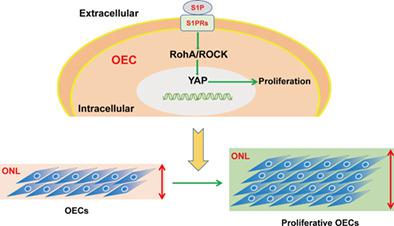Our official English website, www.x-mol.net, welcomes your
feedback! (Note: you will need to create a separate account there.)
Sphingosine 1-phosphate promotes the proliferation of olfactory ensheathing cells through YAP signaling and participates in the formation of olfactory nerve layer.
Glia ( IF 5.4 ) Pub Date : 2020-02-14 , DOI: 10.1002/glia.23803 Xiaomei Bao 1, 2, 3 , Xingxing Xu 2 , Qian Wu 4 , Jingjing Zhang 2 , Wenjin Feng 5 , Danlu Yang 2 , Fayi Li 1 , Sheng Lu 1 , Huitao Liu 1 , Xiya Shen 2 , Fan Zhang 2 , Changnan Xie 1 , Shiyang Wu 1 , Zhaoting Lv 4 , Wei Wang 4 , Hongjuan Li 6 , Yuanyuan Fang 4 , Ying Wang 7 , Honglin Teng 1 , Zhihui Huang 1, 2, 6
Glia ( IF 5.4 ) Pub Date : 2020-02-14 , DOI: 10.1002/glia.23803 Xiaomei Bao 1, 2, 3 , Xingxing Xu 2 , Qian Wu 4 , Jingjing Zhang 2 , Wenjin Feng 5 , Danlu Yang 2 , Fayi Li 1 , Sheng Lu 1 , Huitao Liu 1 , Xiya Shen 2 , Fan Zhang 2 , Changnan Xie 1 , Shiyang Wu 1 , Zhaoting Lv 4 , Wei Wang 4 , Hongjuan Li 6 , Yuanyuan Fang 4 , Ying Wang 7 , Honglin Teng 1 , Zhihui Huang 1, 2, 6
Affiliation

|
Olfactory ensheathing cells (OECs) are unique glial cells with axonal growth‐promoting properties in the olfactory epithelium and olfactory bulb, covering the entire length of the olfactory nerve. The proliferation of OECs is necessary for the formation of the presumptive olfactory nerve layer (ONL) during development and OECs transplantation. However, the molecular mechanism underlying the regulation of OEC proliferation in the ONL still remains unknown. In the present study, we examined the role of sphingosine 1‐phosphate (S1P) and S1P receptors (S1PRs) on OEC proliferation. Initially, reverse transcription‐PCR (RT‐PCR), western blot and immunostaining revealed that S1PRs were highly expressed in the OECs in vitro and in vivo. Furthermore, we found that S1P treatment promoted the proliferation of primary cultured OECs mediated by S1PR1. Mechanistically, yes‐associated protein (YAP) was required for S1P‐induced OEC proliferation through RhoA signaling. Finally, conditional knockout of YAP in OECs reduced OEC proliferation in ONL, which impaired the axonal projection and growth of olfactory sensory neurons, and olfactory functions. Taken together, these results reveal a previously unrecognized function of S1P/RhoA/YAP pathway in the proliferation of OECs, contributing to the formation of ONL and the projection, growth, and function of olfactory sensory neurons during development.
中文翻译:

1-磷酸鞘氨醇通过YAP信号促进嗅鞘细胞增殖,参与嗅神经层的形成。
嗅鞘细胞 (OEC) 是独特的神经胶质细胞,在嗅上皮和嗅球中具有轴突生长促进特性,覆盖整个嗅觉神经。OECs 的增殖是在发育和 OECs 移植过程中形成推定嗅觉神经层 (ONL) 所必需的。然而,ONL 中 OEC 增殖调控的分子机制仍然未知。在本研究中,我们检查了 1-磷酸鞘氨醇 (S1P) 和 S1P 受体 (S1PR) 对 OEC 增殖的作用。最初,逆转录 PCR (RT-PCR)、蛋白质印迹和免疫染色显示 S1PRs 在体外和体内的 OEC 中高度表达。此外,我们发现 S1P 处理促进了由 S1PR1 介导的原代培养的 OEC 的增殖。从机制上讲,通过 RhoA 信号传导 S1P 诱导的 OEC 增殖需要 yes 相关蛋白 (YAP)。最后,有条件地敲除 OEC 中的 YAP 会降低 ONL 中的 OEC 增殖,从而损害嗅觉感觉神经元的轴突投射和生长以及嗅觉功能。综上所述,这些结果揭示了 S1P/RhoA/YAP 通路在 OEC 增殖中的一种先前未被认识的功能,有助于 ONL 的形成以及嗅觉感觉神经元在发育过程中的投射、生长和功能。
更新日期:2020-02-14
中文翻译:

1-磷酸鞘氨醇通过YAP信号促进嗅鞘细胞增殖,参与嗅神经层的形成。
嗅鞘细胞 (OEC) 是独特的神经胶质细胞,在嗅上皮和嗅球中具有轴突生长促进特性,覆盖整个嗅觉神经。OECs 的增殖是在发育和 OECs 移植过程中形成推定嗅觉神经层 (ONL) 所必需的。然而,ONL 中 OEC 增殖调控的分子机制仍然未知。在本研究中,我们检查了 1-磷酸鞘氨醇 (S1P) 和 S1P 受体 (S1PR) 对 OEC 增殖的作用。最初,逆转录 PCR (RT-PCR)、蛋白质印迹和免疫染色显示 S1PRs 在体外和体内的 OEC 中高度表达。此外,我们发现 S1P 处理促进了由 S1PR1 介导的原代培养的 OEC 的增殖。从机制上讲,通过 RhoA 信号传导 S1P 诱导的 OEC 增殖需要 yes 相关蛋白 (YAP)。最后,有条件地敲除 OEC 中的 YAP 会降低 ONL 中的 OEC 增殖,从而损害嗅觉感觉神经元的轴突投射和生长以及嗅觉功能。综上所述,这些结果揭示了 S1P/RhoA/YAP 通路在 OEC 增殖中的一种先前未被认识的功能,有助于 ONL 的形成以及嗅觉感觉神经元在发育过程中的投射、生长和功能。











































 京公网安备 11010802027423号
京公网安备 11010802027423号